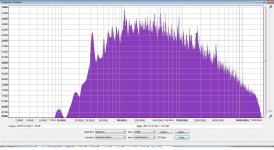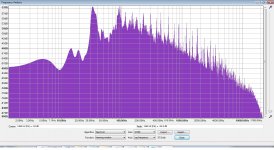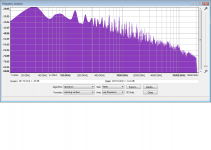Can you remind me how those "DR marks" are relating to alignment level, permissible maximum level and headroom expressed in dBFS?
Well it goes like this, for those unable to google for themselves.
Peak, is well peak, ref to dBFS
RMS is well RMS.
The rest I would hope you can work out for yourself. Safe to say that the broadcast levels you speak of there are nowhere to be found in the music we buy.
Yes. Whereas there is no strict FS in vinyl mastering, no little clip light, no rule as to how hot and what unnatural compression happens above nominal 0dB and high slews. This is another key difference relevant to the OP, IMO, and was (still is !) an artistic way round the dynamic range 'limitations' of vinyl for mastering engineers.
Though shalt not exceed 5cm/S. Imagine ! 😱
On this, how easy is it to work back from a digital rip to get to the max slew rate? I have some albums that were 'best ofs' with 30 mins a side and others like the telarc 1812 with some significant excursions (oh and some direct to disk organ music).
Some of the finest classical recordings on vinyl have ambient sounds which extend way into subsonic and were not filtered. Some Decca recordings made in Kingsway Hall in the 60s in London had an underground train line making regular contributions that can seriously shake the room! Especially in classical recordings, building ambience is important to realism, and was not filtered during mastering onto vinyl at least on Decca as a rule. You won't get that with yer modern digital mastering..........Back to low freq. noise. Easiest "proof" I can think of is to filter out the LF of a record with music that dosnt have much LF and see if the music sounds worse. I kinda doubt it.
This was already responded to, but I want to explain why. This was true only of older digital recordings, before sigma-delta converters were widely used in audio, and before dithering/noise shaping was understood and widely used in audio. In any modern digital recording system, distortion does NOT increase relative to a decreasing signal, only noise does, the same as analog.Surely the main difference between vinyl and digital (CD or whatever) is that with vinyl the level of distortion starts low and increases with amplitude whereas with digital media the distortion level Increases as amplitude Decreases (less bits in play).
Here's an old (1992, but it references articles as old as 1951) National Semiconductor app note that shows how dither works:
http://www.ti.com/general/docs/litabsmultiplefilelist.tsp?literatureNumber=snoa232
Another thing, with the distortion and noise lumped in together to a single THD+N dB number, it's impossible to tell how much is (harmonic or IM) distortion and how much is noise.@Gyro: At -60dB vinyl THD+N is what 10dB down, 20 on a good day? How is that starting low?
Easy if you're familiar with spice simulators......use the rip as a piecewise source as an input to a simple differentiator circuit, and viola the output is slew rate.On this, how easy is it to work back from a digital rip to get to the max slew rate? I have some albums that were 'best ofs' with 30 mins a side and others like the telarc 1812 with some significant excursions (oh and some direct to disk organ music).
It's made complicated by RIAA to get back to what is physically on the record, so a reverse RIAA is needed somewhere in the chain, or a RIP with no RIAA correction.
As far as raw cartridge output is concerned:
stylus velocity = groove angle = programme signal amplitude
stylus acceleration = groove curvature = programme signal slew rate
Typical trackability limits work out about 40 deg groove angle and about 800G acceleration (curvature) and mastering seldom exceeds these IME. Both get increasingly stressed on inner grooves ie angles and curvature increase for any given programme material.
Well it goes like this, for those unable to google for themselves.
Peak, is well peak, ref to dBFS
RMS is well RMS.
The rest I would hope you can work out for yourself. Safe to say that the broadcast levels you speak of there are nowhere to be found in the music we buy.
Except it's important to know how often that "peak" was reached. Was it "accidental" or "systematic"? Judging by RMS, it looks more like "accidental".
Some of the finest classical recordings on vinyl have ambient sounds which extend way into subsonic and were not filtered. Some Decca recordings made in Kingsway Hall in the 60s in London had an underground train line making regular contributions that can seriously shake the room! Especially in classical recordings, building ambience is important to realism, and was not filtered during mastering onto vinyl at least on Decca as a rule. You won't get that with yer modern digital mastering..........
More recently and non classical, Cowboy Junkies' 1987 "The Trinity Session" was recorded in a church above a subway line. The rumbling is very shaking - if you have the equipment.
Especially in classical recordings, building ambience is important to realism, and was not filtered during mastering onto vinyl at least on Decca as a rule. You won't get that with yer modern digital mastering..........
Never heard the kingsway rumble, but never had a full range system before. Well have capability and never set it up. The xmas Round Tuit means that will change. Do you have any prime examples as I have the decca sound CD box set so can go hunting. Come to think of it I got the dupre box set for xmas and a load of those are kingsway hall.
On the mastering side, which may be pertinent to the topic, in doing some digging last year I found that, in general if a 5.1 release has been done, the 2 channel layer has more low end than if something was just released in stereo. I need to analyse more but couple of examples.
First is Mahler 9 by the Halle recorded I believe in a fairly small space
second is shostakovich by liverpool phil on Naxos (so 2 channel). The last is Fucik (sorry for lack of accents) on Chandos, which was the red book layer of the SACD.
Too few points to make any meaningful conclusions and the amount of thump and bang on percussion will vary things a lot, but there is certainly something for me to dig futher on. It is a shame that gramophone don't bother with recording quality any more...
Attachments
Except it's important to know how often that "peak" was reached. Was it "accidental" or "systematic"? Judging by RMS, it looks more like "accidental".
You never heard of crest factor? Note the difference between VU and peak on the screenshot. VU is within spitting distance of RMS as calculated here.
Attachments
It's made complicated by RIAA to get back to what is physically on the record, so a reverse RIAA is needed somewhere in the chain, or a RIP with no RIAA correction.
Scott has put the gauntlet down on using MiniDSP for RIAA correction, so on the long list is an RIAA free phone stage. sometime...
Easy if you're familiar with spice simulators......use the rip as a piecewise source as an input to a simple differentiator circuit, and viola the output is slew rate.
And it works for other stringed instruments too.
I can tell ya why Dougee 🙂DouglasSelf said:An intriguing theory has been put forward in the Letter section of Hifi News (December 2015, p123) as to why people assert they prefer vinyl to digital, despite the undeniable problems with noise, distortion, clicks, etc etc.
Analog is natural,analog is WARM <<>> Analogue is beautiful!!
DIGITAL IS ARTIFICAL CRAP .... Flat,VOID,etc.........
Several of my records DO NOT HAVE ANY SURFACE NOISE..... They are simply georgeous!!!!
Last edited:
There will be a difference between early stereo recordings like the Beatles, mixed L,R and no centre and then mastered with low frequency crossfeed and more sensible mixes with the bass panned to centre. Crossfeed will attenuate the bass a little when it was only on one side or end up boosting it when it was on both channels....Anyway, all we have to do on the hardware side is come up with an LF-crossfeed circuit that can be switched in and out without level or phase changes. The more difficult bit will be proper double-blind testing to see if attenuating the LF antiphase information removes the 'ambience' or 'anticipation' effect....
SY, you write, "Because it is. Theoretically ..."
I thought that I understood digital rather well, based on the Fourier Theorem and the Shannon Theorem. You specifically mention "theory" - could you please elaborate? Also, when I looked at newer discussions of digital just now, it seemed like the same old. Could you please give me a reference which you admire?
Thank you.
I thought that I understood digital rather well, based on the Fourier Theorem and the Shannon Theorem. You specifically mention "theory" - could you please elaborate? Also, when I looked at newer discussions of digital just now, it seemed like the same old. Could you please give me a reference which you admire?
Thank you.
https://xiph.org/video/vid2.shtml is often recommended - but being allergic to video I've never watched all the way thru
too much more: https://people.xiph.org/~xiphmont/demo/
too much more: https://people.xiph.org/~xiphmont/demo/
I can tell ya why Dougee 🙂
Analog is natural,analog is WARM <<>> Analogue is beautiful!!
DIGITAL IS ARTIFICAL CRAP .... Flat,VOID,etc.........
Several of my records DO NOT HAVE ANY SURFACE NOISE..... They are simply georgeous!!!!
Neil Young on diyaudio!
I see what you did there.And it works for other stringed instruments too.
You should take a bow. 😉
Sorry, what's the LF cross-feed circuit going to look like? Something special with phase - or just mixing LF below certain frequency?
- Status
- Not open for further replies.
- Home
- Source & Line
- Analogue Source
- Hypothesis as to why some prefer vinyl: Douglas Self



